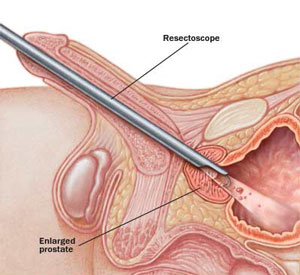Transurethral Resection of the Prostate (TURP) (Part One)

Transurethral Resection of the Prostate (TURP) is one of the surgical methods used for the treatment of benign prostate enlargement (abbreviated from English as BPE or BPH) accompanied by urinary symptoms ranging from moderate to severe.
TURP is performed using a combined visual-surgical instrument (resectoscope) that is inserted through the tip of the penis into the urethra (the tube through which urine passes from the bladder and is expelled outside). The urethra is surrounded in the initial part by the prostate.
The enlargement of the prostate causes the diameter of the urethra to reduce, as a result, making it difficult for urine to pass. Through the resectoscope, the prostate is removed piece by piece, causing the urethra to widen and urine to freely pass, emptying the urinary bladder.
TURP is one of the most effective methods for treating urinary symptoms caused by BPH. To determine which treatment method is best for a particular patient, the doctor considers how severe the symptoms are, whether there are other health problems, and the size and shape of the prostate.
Why TURP should be done
TURP helps in reducing symptoms caused by prostate enlargement (BPH).
The urinary signs caused by BPH are:
- Frequent and urgent urination
- Difficulty starting urination
- Slow and prolonged urination
- Frequent urination at night
- Stopping and starting again during urination
- Feeling of not completely emptying the bladder
- Urinary tract infections
- Inability to urinate
TURP can also be performed for the treatment or prevention of complications from urine blockage as a result of:
- Repeated urinary tract infections
- Damage to the kidneys or bladder
- Inability to control urination (incontinence)
- Bladder stones
- Repeated bloody urination
TURP is the most common procedure in the treatment of BPH although there are other treatment procedures. TURP and other methods come with risks and complications that should be discussed with the doctor.